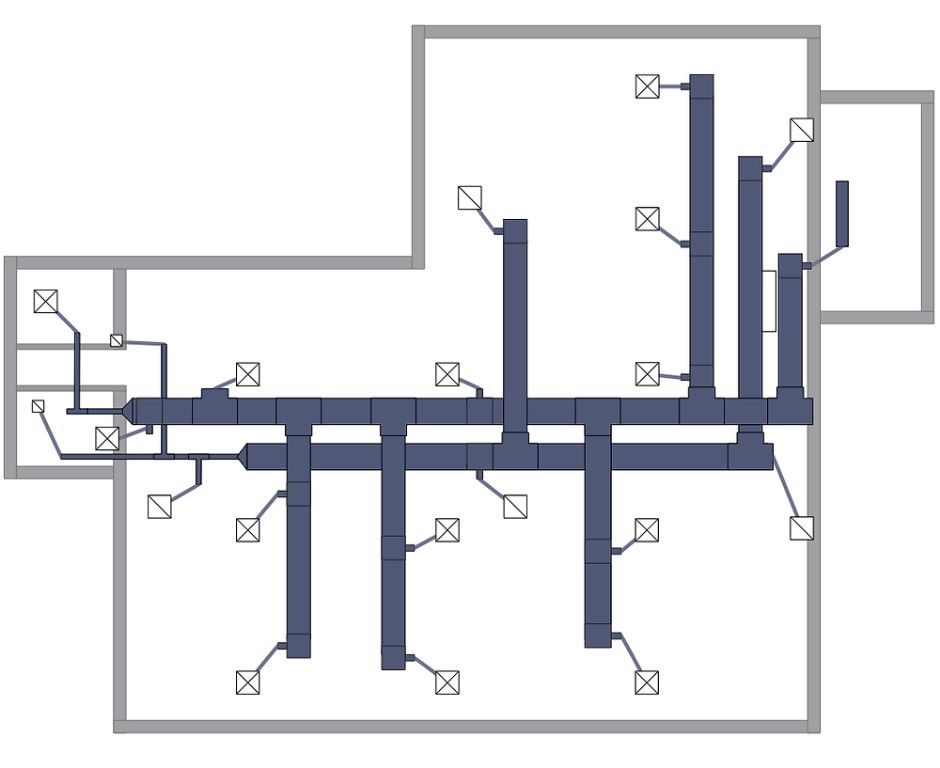Can You Split A 6 Duct?
What is a 6 duct?
A 6 duct air conditioning system is a type of ducted HVAC (heating, ventilation and air conditioning) system that utilizes six main supply air ducts to deliver conditioned air throughout a building.
In a typical 6 duct system, a central air handler or rooftop unit is connected to six large supply ducts that branch out to different zones of the building. The air handler contains a blower fan that pushes air through cooling and/or heating coils, then distributes it through the ductwork. Compared to a standard 4 duct system, a 6 duct system has two additional main supply ducts coming off the air handler.
Some key pros of a 6 duct system include:
- More even distribution of air
- Lower static pressure as the airflow is divided between more ducts
- Allows serving larger buildings or homes
Some potential cons include:
- More complex ductwork required
- Higher installation cost
- More space needed for additional duct runs
Overall, a 6 duct system provides enhanced airflow and conditioning capacity for large residential and commercial spaces compared to smaller 4 duct or ductless systems.

When might you want to split a 6 duct?
There are a few main reasons why you may need to split a 6-inch duct in an HVAC system:
To add cooling/heating to a new room – When building an addition or converting an unfinished space into a bedroom or office, you’ll need to extend the ductwork to provide conditioned air. Splitting an existing 6-inch duct and running two smaller branches is often easier than installing an entirely new duct run.
According to this DIY Chatroom thread, it’s typically okay to cut into a main duct line as long as you follow proper spacing guidelines.
To balance airflow if some rooms get too much/too little – Over time, ductwork can become unbalanced, resulting in uneven cooling or heating between different rooms. Splitting a supply duct allows you to install dampers and fine-tune the airflow to different branches until each room gets sufficient air.
As mentioned in this HVAC forum post, splitting a 6-inch duct into two smaller ducts with dampers gives you more control to correct any imbalances in air delivery.
How to Split a 6″ Duct
Splitting a 6″ duct is a relatively straightforward process that can be done by a handy homeowner. Here is an overview of what’s involved:
To split a 6″ duct, you will need the following equipment:
- Duct splitter
- 6″ to 4″ reducer
- 4″ flexible ductwork
- Metal snips or saw to cut rigid ductwork
- Screws and tape to connect ductwork
The basic steps are:
- Locate the section of 6″ duct you want to split. This is often done to route ductwork into two separate rooms from a central trunk.
- Measure and mark where you will cut the 6″ duct. Cut through the duct with metal snips.
- Install a duct splitter fitting over the open end of the cut duct. The splitter will have two 4″ outlets.
- Connect 4″ flexible ductwork to each of the splitter outlets. Secure with screws and tape.
- Install a 6″ to 4″ reducer on the open end of the duct leading to the first room.
- Connect the 4″ flexible ductwork coming off the splitter to the reducer using screws and tape.
- Repeat this process for the second room.
- Test your work by running the HVAC system and checking airflow at the registers.
- Make any airflow adjustments using dampers in the flexible ductwork.
It’s important to support the ductwork properly and make sealed connections. Refer to this DIY Chatroom thread for more tips on smoothly splitting a 6″ duct.
Installing dampers when splitting a 6 duct
The purpose of installing dampers in a split 6 duct system is to balance and control airflow. Dampers help direct air to different branches and rooms and prevent air from flowing where it’s not needed. There are two main types of dampers:
Manual dampers: These are operated by hand to open and close duct branches. They are simple and inexpensive but require manual adjustment. An example is the 6″ Diameter Manual Air Damper which inserts inside a 6″ collar to manually damper airflow (source).
Automated dampers: These can be remotely controlled to open and close automatically based on settings. They allow for more precision in balancing airflow but have a higher upfront cost. An example is the SmartZone modulating damper for supply air control in duct systems (source).
It’s recommended to install dampers close to where the 6″ duct splits into branches for most effective airflow control. Usually a damper is installed in each branch duct to balance air to different rooms as needed. The Master Flow Inline Damper is designed to easily install into existing duct runs to help balance airflow (source).
Balancing airflow in a split 6 duct system
When splitting a 6 inch duct into two smaller ducts, it’s important to balance the airflow to avoid problems like insufficient heating or cooling in parts of the home. Using adjustable dampers in each smaller duct is crucial for optimizing airflow.
Signs that the airflow is imbalanced include some rooms feeling drafty or stuffy while others are comfortable. You may also notice temperature variations between rooms or hear whistling from ducts as air blows by at high speed.
Tools like anemometers can precisely measure airflow speed allowing you to adjust the dampers until airflow is balanced. Anemometers are affordable devices you attach to duct openings to read CFM (cubic feet per minute) measurements. Adjust dampers slowly while checking airflow speeds until they are equalized as recommended by your HVAC system design.
Balancing airflow ensures comfort and proper HVAC performance after splitting a larger duct. Careful damper adjustments paired with airflow measurements let you fine tune the system. Refer to resources like this guide for more details on the air balancing process.
Cost to split a 6 duct system
Split duct systems involve additional ductwork, dampers, and labor, increasing the cost compared to a standard ducted system. The total cost to split a 6 duct system will depend on several factors:
Labor costs make up a significant portion of the total project cost. HVAC technicians typically charge $50-$100 per hour for ductwork modifications. Complex systems with multiple zones require more time to properly configure dampers and balance airflow. Expect 10-25 labor hours for a 6 duct split, so labor alone can cost $500-$2500.
Material costs also add up. Duct splits require additional ductwork, dampers, grilles, and other hardware. Cost per linear foot of ductwork ranges $3-$8 for common sizes. A complex 6 zone system may require $1000 or more in materials.
In total, expect to pay $2000-$4000 to split a 6 duct system for a typical single family home. Larger homes or complex, multi-zone systems with premium materials can cost $5000-$8000 or more. Get multiple HVAC contractor estimates to compare costs for your specific project.
To save on installation costs, consider simpler options like a dual-zone system with fewer dampers and duct splits. Proper design is also key – minimizing duct length and complex routing cuts down on materials and labor time.
Sources:
https://www.forbes.com/home-improvement/hvac/mini-split-installation-cost/
https://www.thisoldhouse.com/heating-cooling/reviews/split-ac-installation-cost
Alternatives to splitting a 6 duct
There are a few options that can provide additional cooling without splitting the existing 6 inch ductwork. Two popular alternatives are upgrading to a multi-zone system or adding mini-split units.
Upgrading to a multi-zone HVAC system is one way to get improved comfort without major duct modifications. This type of system has multiple air handlers and condensing units, allowing different zones of the home to be controlled independently. The existing 6 inch ducts can supply air to one zone, while new ductwork is added to condition other zones as needed. This gives improved control over temperatures compared to a single central system. According to Unique Heating and Cooling, a multi-zone system may be an ideal solution for older homes without adequate ductwork.
Adding ductless mini-split air conditioners is another option for supplementing an existing HVAC system without ductwork changes. Mini-split units are self-contained systems with an outdoor compressor connected to one or more sleek, compact indoor heads mounted high on the wall. The indoor units can be installed in rooms that need extra cooling without any duct modifications. Mini-splits allow zoning and individual temperature control for each room. They can be a cost-effective way to improve comfort in specific areas without altering existing ducts, according to answers on Quora.
With either a multi-zone system or mini-splits, homeowners can get better cooling performance without the major undertaking of splitting or replacing 6 inch ductwork throughout the home.
Maintaining a split 6 duct system
Regular maintenance is crucial for a split 6 duct system to operate efficiently and have a long lifespan. Some important maintenance tasks include:
Checking dampers and airflow annually – The dampers that regulate airflow when the 6 duct was split should be inspected yearly. Ensure dampers are operating properly and airflow is balanced to each zone.[1]
Filter changes – Air filters should be checked every 3-6 months and replaced as needed. Clogged filters put strain on the HVAC system and reduce efficiency.[2]
Checking for problems – Listen and look for any unusual noises, leaks, or drips which could indicate an issue. Have repairs done promptly to avoid further damage.[3]
Pros and cons of splitting a 6 duct
Splitting a 6 duct into multiple smaller ducts has both advantages and disadvantages. Here are some of the key pros and cons to consider:
Pros:
- Targeted temperature control – With separate ducts you can better control temperatures in different zones of the home. This allows you to customize comfort in each room.
- More efficient cooling/heating – Smaller ducts with shorter runs to vents are more energy efficient than one large duct covering a wide area.
- Retrofit option – Splitting a duct can be easier and cheaper than installing a whole new duct system.
Cons:
- System imbalance – Improper duct splitting can result in too much air to some rooms and not enough to others.
- Higher installation cost – Adding dampers and splitting a duct is more labor intensive than a single duct install.
- Reduced total airflow – Multiple smaller ducts may restrict airflow vs. one larger duct.
Overall, the benefits often outweigh the downsides when properly designed and installed. Consulting an HVAC professional is recommended when considering splitting a 6 duct.
Conclusion
Splitting a 6 duct can provide benefits in some situations but also has downsides to consider. The key points are:
- Splitting a 6 duct allows you to control airflow to different zones in your home or building.
- Installing dampers is crucial for balancing airflow when splitting a duct.
- It can be costly to split a duct due to the dampers and labor for installation.
- Alternatives like adding additional ducts or registers may be simpler and cheaper in some cases.
- A split system requires maintenance to keep dampers and ducts clear of obstructions.
Overall, splitting a 6 duct makes sense if you need precise control over heating or cooling in different areas. But it’s not necessary in all homes and comes at a higher upfront cost. Consider your specific needs and goals. In some cases, adding ducts or registers may provide adequate zoning without splitting a main duct. Consult HVAC professionals to determine the best solution for your home.




